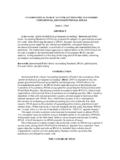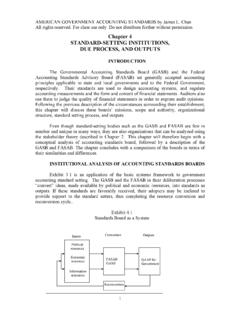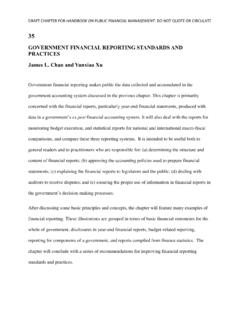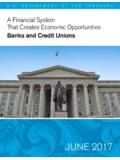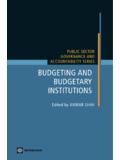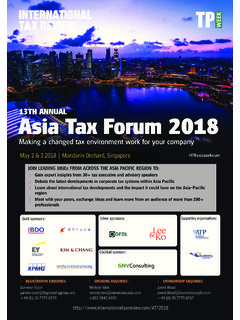Transcription of Miranda, JLC - Principles for Designing the Finance ...
1 Principles for Designing the Finance organization : A Guide for reform efforts and leadership Transitions by James L. Chan and Rowan Miranda Since the turn of the century, many state and local governments have reformed their organizational structures by centralizing authority and clearly defining lines of responsibility. Over time, additional modifications were made through reorganizations by newly elected officials, changes in statutes, and external forces. Today, the Finance organization for many state and local governments is more the result of incremental piecemeal changes than thoughtful and rational design. Especially in larger governments, Finance organizations are associated with terms such as red-tape, bureaucracy, overlap, and duplication. Incremental efforts at reorganizing the Finance function have at best produced marginal benefits. If genuine reengineering of the Finance function occurs through the combination of technology modernization and organizational restructuring, it is useful to establish some fundamental Principles to guide reform efforts .
2 In this article, the authors propose a small number of Finance organization design Principles and illustrate their application by examining the recent charter reform effort in the City of Los Angeles. The term Finance organization is used to encompass all of the financial management units in the government. leadership transition teams and charter reform efforts in other jurisdictions can use these Principles to guide their restructuring efforts ; those that have made recent changes can use the Principles to evaluate past actions. Design Principles In the authors view, institutional designers should consider the following seven Principles . An effective Finance organization : has a scope that is comprehensive enough to carry out major Finance activities, establishes independence for key Finance activities, helps the government and its managers discharge accountability, contributes expertise to influence policy formulation and implementation, improves the performance of service delivery, minimizes overhead costs of itself and the government as a whole, and makes continuous improvements.
3 Comprehensive Scope Principle. An effective Finance organization should have authority and responsibility sufficiently comprehensive in scope to encompass the core and related Finance functions. The core functions are financial planning and budgeting, implementation (including budget execution, accounting, and reporting), and financial performance evaluation (including auditing). The related functions include purchasing, risk management, and evaluation of compliance with Finance -related laws and regulations. Unless the Finance organization as a whole encompasses these functions, it runs the risk of frequent turf wars that lead to conflict and inefficiency. Independence Principle. The government should ensure independence for certain key Finance activities such as auditing and financial reporting. Such independence is essential to promoting the confidence of the public and the financial community.
4 These resource providers view checks and balances in government as ways to prevent fraud and waste. Accountability Principle. A successful Finance organization strengthens accountability. There are three mutually reinforcing lines of accountability in state and local government. Department heads are accountable to higher-level executive officers. The executive branch is accountable to the legislative body. And the government as a whole is accountable to voters and taxpayers. Since financial accountability is an integral aspect of performance, the Finance organization is instrumental in both demonstrating and enforcing accountability. Timely release of the budget document and the annual audit are two well-established means of demonstrating accountability. Policy Influence Principle. An effective Finance organization does more than implement controls. When resources are scarce, financial considerations often make or break policy or program proposals.
5 The Finance organization should possess the expertise to provide objective information and advice in policy formulation and implementation. Its senior members often participate in deliberations of financial strategies, and are actively involved in high-level decision making. This consideration should be examined in Designing a Finance function especially as it relates to the appointment of a chief financial officer (CFO). Service Performance Principle. An effective Finance organization is staffed by individuals who are familiar with operations and can work with the line departments to analyze and implement alternative service delivery approaches. Finance staff should be able to apply their cost accounting knowledge to help the service departments measure performance, change practices, and organize efficiently. Exhibit 1 Attributes of an Effective Finance Structure Principle Organizational Attributes Comprehensive scope Finance activities should either fall under a Finance unit or be subject to its guidance.
6 Independence Maintains the trust and confidence of the public and financial community. Has the capacity to detect/prevent fraud, waste, and abuse. Promotes checks and balances. Accountability Exercises financial discipline on government. Has a clear line of authority and responsibility. Facilitates meaningful citizen participation in the budget process. Develops the capacity to carry out adopted policies and programs. Policy influence Provides objective information and advice to decision makers. Has established standard operating procedures for making and carrying out financial decisions. Service performance Executes decisions and transactions on a timely basis. Has capacity to promote continuous process and policy improvements in other government departments. Is responsive to department heads needs and concerns. Monitors and effectively oversees operating departments Finance operations.
7 Overhead minimization Minimizes duplication and gaps among units in the Finance organization . Minimized administration cost of financial transactions. Fosters coordination between city-level and departmental Finance staff. Continuous improvement Takes advantage of modern information technology. Adopts best practices from private industry and other governments. Overhead Minimization Principle. Budgeting and financial management are necessary administrative overhead for the government as a whole. As such, they are particularly vulnerable when efforts are made to streamline government operations. The Finance organization should itself be a lean and mean operation so that it can have greater credibility in dealing with other government agencies. In addition, Finance organizations should seek to reduce the costs of doing business within government. Continuous Improvement Principle.
8 Like their counterparts in the private sector, government Finance organizations should have the capacity to adapt to changes in their external environment. Consequently, reformers should ask what aspects of the organization s design should be institutionalized in city charters, or alternatively in ordinances, rules, and procedures. Governments are operating today in a different technological environment. Advances in information technology may make it possible to simplify organizational procedures while retaining control. Finance organizations must therefore be flexible enough to adopt changes that improve the effectiveness and efficiency of the government as a whole. These Principles are embodied to varying degrees in most government Finance organizations. Exhibit 1 identifies specific attributes of an effective Finance structure. These attributes can be used to evaluate the performance of the current organization .
9 They can also be used as basis for a before and after comparison of organizational changes. Organizational Design Issues While American state and local governments have a largely common set of budgeting and financial management functions, they have varied organizational structures for carrying out these activities. Often the differences can be attributed to the size of a jurisdiction. For local governments, the Finance function of smaller jurisdictions tends to be headed by a Finance director who is responsible for budgeting and a broad range of financial management functions. Separation of duties in order to strengthen internal control is difficult because of the small size of the Finance staff. On the other hand, states and large local governments tend to have an elaborate structure combining appointed and elected officials in Finance positions. In Designing the Finance organization , the following issues also need to be addressed: elective vs.
10 Appointive offices legislative oversight and micro-management the appointment of a CFO central vs. departmental Finance staffs definition of Finance functions autonomy of enterprise activities. Elective vs. Appointive Offices. Are citizens better served by elected or appointed officers? In some cities, especially large ones, one or more of the offices of the comptroller, auditor, or treasurer are elective. Normally the status of these offices is not open to change through routine reorganizations. If a city is considering charter changes, this can be a major political issue, as any change would disturb the balance of power in city government. Defenders of elective offices can cite higher public visibility and greater political independence and ability to secure resources. Detractors, on the other hand, point to possible headline-seeking behavior and the frequent lack of requirements of professional qualifications in Finance for the candidates.

